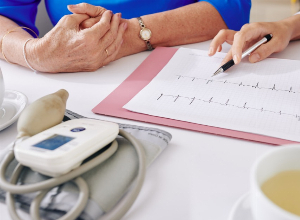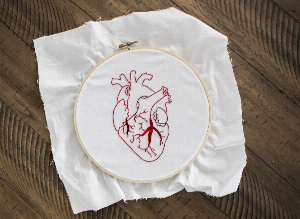Cardiovascular disease in women: why should its signs be taken more seriously?
Published Apr 21, 2023 • By Claudia Lima
For a long time, it was believed that only men suffered from cardiovascular conditions. Today, these conditions are the leading cause of death for women. For the most part, this is due to delays in treatment, which means that cardiovascular disease has become a symbol of inequality between women and men in the field of health.
Are women at greater risk of developing cardiovascular disease? What are the symptoms to be aware of in women? How can cardiovascular conditions be prevented in women?
Read our article to find all the answers!

Why are women more exposed to cardiovascular conditions?
Cardiovascular disease is a major health problem around the world.
The most common risk factors for men and women to develop cardiovascular disease are age, smoking, obesity, lack of physical activity, poor diet and type 2 diabetes.
In the past, it was thought that cardiovascular disease only affected men who were overweight, smokers and were over 50 years old. This belief was linked to the fact that studies on cardiovascular disease mainly involved men, so there was not enough medical knowledge about women. The consequences today are that women are less well treated than men, with treatments that do not take sufficient account of their specific metabolic characteristics.
Also, women's lifestyle has changed in the past decades, and they have become more exposed to cardiovascular risk factors such as smoking, alcohol, sedentary lifestyle and stress. Women's lifestyle has changed, but not the perception of risks leading to the development of cardiovascular diseases, which is the cause of many delays in diagnosis and treatment.
Today, women are more likely to suffer from cardiovascular disease than men and this trend increases with age. They are more at risk because of hormonal changes during pregnancy, breastfeeding, menopause and the use of certain medications (e.g. the contraceptive pill).
The most common cardiovascular diseases in women are the same as in men: angina pectoris (angina), myocardial infarction, stroke and thrombosis.
What are some particular signs of cardiovascular disease in women?
For some cardiovascular diseases, the signs are different for women and men.
According to the latest studies, there is a lack of awareness of these diseases and their mortality rate among women themselves.
Here are the signs of heart disease that should alert women:
Chest pain and heart palpitations
A pain in the chest, behind the breastbone, which radiates into the arm and the jaw, sometimes with the desire to vomit, as well as heart palpitations. These pains must be very intense and persist for more than 5 to 10 minutes.
Chronic shortness of breath
Dyspnea is chronic when it lasts for several weeks, at least 8. It can lead to heart muscle exhaustion.
Waist circumference of more than 3.15 inches
Excessive visceral fat can lead to diabetes, high blood pressure, atherosclerosis and liver disease. If the waist circumference is greater than 3.15 inches in the abdomen, this may be the beginning of a metabolic syndrome.
Heartburn
Ulcer-like digestive symptoms such as recurrent heartburn may be a sign of coronary heart disease. They are sometimes associated with palpitations, shortness of breath, abnormal fatigue, back pain or burning in the throat. They occur with increasingly moderate efforts in daily life, when it is very cold or when smoking.
Prolonged back pain
Prolonged and continuous pain in the back, which increases when inhaling, often associated with fever and severe fatigue, can be a sign of pericarditis.
Migraines with aura
If they are recurrent and accompanied by visual disturbances, paresthesias in the hand, the desire to vomit or difficulties in speaking, they are linked to an increased risk of stroke. Especially in women on oral contraceptives and those who smoke.
Lipoedema
Sudden weight gain accompanied by leg swelling, fatigue, anxiety and palpitations can be a warning sign of cardiovascular disease, such as heart failure.
Pains while walking
A stabbing pain in the buttock, calf or arch that occurs only when walking and stops when at rest. This may indicate obliterative arterial disease of the lower limbs.
Unexplained fatigue or dizziness
They can be a sign of low cardiac output, bradycardia or a blocked coronary artery.
Snoring
Beware of sleep apnea, it is associated with a higher risk of stroke, myocardial infarction, metabolic syndrome and aortic dissection.
Other symptoms include sweating, nausea or vomiting, feelings of discomfort and tightness and loss of appetite.
How to prevent cardiovascular disease in women?
Recommendations for preventing cardiovascular disease are the same for men and women. Specific recommendations exist for women during vulnerable periods of their lives, such as when taking the contraceptive pill, during pregnancy or the menopause.
These recommendations include:
- Stopping smoking,
- Avoiding being overweight,
- Avoiding sedentary lifestyle,
- Eating a healthy diet,
- Controlling your blood pressure regularly.
Early screening for all women with risk factors should be offered by healthcare professionals, as well as an exercise test for those wishing to resume physical activity after the age of 45.
It should be noted that, at the same age, women have more cardiovascular risk factors than men. They are also more concerned by a mental burden and too often hesitate to see a doctor, minimizing their symptoms.
Researchers are working to prevent cardiovascular disease, but also to improve the management of cardiovascular disease in women by gaining a better understanding of the particularities of cardiovascular risks in women.
Share your thoughts and questions with the community in the comments below!
Take care!
Sources :
Maladies cardiovasculaires chez les femmes : un risque largement sous-estimé, axaprevention.fr
Problème cardiaque : 10 symptômes à surveiller chez la femme, sante.journaldesfemmes.fr
Symptômes et prévention, fondation-recherche-cardio-vasculaire.org
Les femmes et les maladies cardiovasculaires, fedecardio.org
Maladies cardiovasculaires des femmes : alerte rouge, agirpourlecoeurdesfemmes.com

 Facebook
Facebook Twitter
Twitter


